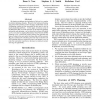Free Online Productivity Tools
i2Speak
i2Symbol
i2OCR
iTex2Img
iWeb2Print
iWeb2Shot
i2Type
iPdf2Split
iPdf2Merge
i2Bopomofo
i2Arabic
i2Style
i2Image
i2PDF
iLatex2Rtf
Sci2ools
104
Voted
AAAI
1998
1998
Control Strategies in HTN Planning: Theory Versus Practice
AI planning techniques are beginning to find use in a number of practical planning domains. However, the backward-chaining and partial-order-planning control strategies traditionally used in AI planning systems are not necessarily the best ones to use for practical planning problems. In this paper, we discuss some of the difficulties that can result from the use of backward chaining and partial-order planning, and we describe how these difficulties can be overcome by adapting Hierarchical Task-Network (HTN) planning to use a total-order control strategy that generates the steps of a plan in the same order that those steps will be executed. We also examine how introducing the total-order restriction into HTN planning affects its expressive power, and propose a way to relax the total-order restriction to increase its expressive power and range of applicability.
| Added | 01 Nov 2010 |
| Updated | 01 Nov 2010 |
| Type | Conference |
| Year | 1998 |
| Where | AAAI |
| Authors | Dana S. Nau, Stephen J. J. Smith, Kutluhan Erol |
Comments (0)

